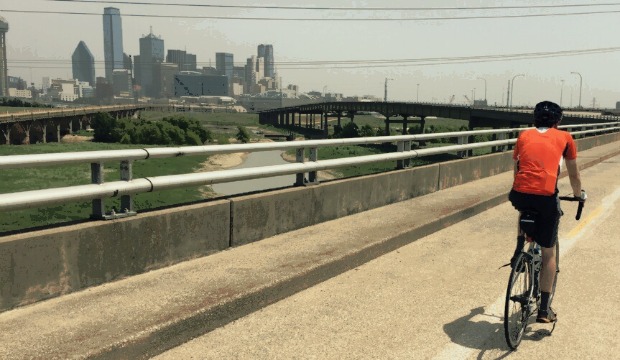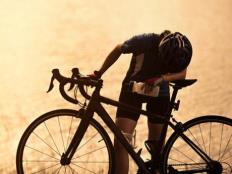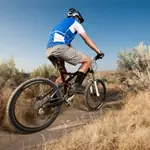

Follow Active.com Editor Brian Kendall as he trains for his first century ride. Check out his last entry here.
Quick Tip
Pain in cycling is inevitable and constant. Once you overcome one affected area—cramping legs, numb feet, sore back, etc.—another pops up to take its place. It’s not that this newly discovered pain wasn’t always present; just that there was another pain far more excruciating that demanded your undivided attention.
While I finally mastered the art of nutrition to keep my muscles from abandoning me with 30 miles remaining of a 70-mile ride, another brutal element of cycling recently introduced itself: the heat.
Sweat flows from every square inch of your body and your chamois becomes a makeshift sponge.
Anyone who lives below the 40th parallel and is dumb, crazy or senseless enough to go on long rides in the middle of July knows the feeling.
Sweat flows from every square inch of your body and pools on the back of your neck and the insides of your elbows. Your chamois becomes a makeshift sponge, and your face feels like it has the hot coils of an oven radiating a mere two inches from it.
While staying in motion and creating an artificial sense of wind provides some relief, using your pedal stroke as a way to generate the sensation of fanning oneself is hardly sustainable for the long haul.
Here are seven tips I’ve picked up during long summer rides in hell, I mean Texas.
1. Acclimate Yourself
Unfortunately, the only way to get used to riding in the heat is to, well, ride in the heat. You couldn’t possibly imagine it on your first 100-degree ride, but you do acclimate fairly quickly (14 days after riding every day). After time, you’ll notice your heart rate and body temperature decreasing during these scorching efforts. We would even venture to say the devil himself is rather cozy in his confines.
2. Early Bird Gets the Cool Ride
The coolest time of day is just before sunrise. In Texas in July, that’s between 6 and 7 a.m. In fact, there’s a 15-degree difference between 6:30 a.m. and 3:30 p.m. So, if you want to get in at least a couple hours of not-completely-miserable riding, get an early start.
While I’m the furthest thing from a morning person, the thought of avoiding 100-degree weather makes me spring from my bed.
3. One Bottle of Water to One Bottle of Skratch
While ice-cold water might sound refreshing, and you can certainly stay fully hydrated by sipping water at your desk, you need more than H2O on a long, hot ride. I recommend keeping one bottle full of water and the other with a product like Skratch Labs Exercise Hydration Mix, which contains important electrolytes. In layman’s terms, these electrolytes allow your body to retain water and evade cramps.
Another quick tip: Stop being cheap and get yourself some damn good insulated water bottles that keep ice for longer than five minutes.
4. Forfeit Drinking a Little Water and Squirt it on the Back of Your Neck
You can almost hear the sizzle after dousing your sun-scorched neck with cool water.
This is far from being a waste of your precious H2O and will provide more instant relief than any other remedy. In fact, it’s been scientifically proven that your heart rate immediately decreases after coming in such contact with water.
5. Drink Every 15 Minutes
Hydrate, hydrate, hydrate. These are rules No. 1, 2 and 3 to having a safe ride during the dog days of summer.
Get in the habit of drinking consistently throughout your ride, even when you’re not thirsty, as the dehydration process begins long before you start craving liquids. As a general rule of thumb, you should consume 4 to 8 ounces of fluid every 15 minutes.
As gross as it may be, take notice of the color of your pee. If it’s dark yellowish, you need to drink more. If you’ve been riding for three hours and haven’t had the urge to pee, you need to drink more. A light yellow color generally means you’re properly hydrated.
6. Do Not Put Sunscreen on Your Forehead
One of the biggest mistakes I made on a recent training ride was applying my SPF 50 sunscreen to my forehead. This is both pointless and, as I found 20 miles into my ride, incredibly painful.
Your helmet combined with a cycling cap (more on this next) should provide enough shade to keep your forehead from getting burnt, so any sunscreen spread above your eyes is an utter waste. You’ll also find, after sweat begins dripping from your wavy locks, that sunscreen really, really burns your eyes.
7. Wear a Sweat Guard
If, like me, you are a prolific sweater, then the sodium dripping into your eyes should clue you in to investing in a sweat guard. While you might think you can tough it out, I’ve ridden far too many miles with a lack of depth perception due to one eye being shut.
Sweat guards take many forms, from cycling caps to bandanas to headbands. Like all things in this wonderful sport, it’s about finding the one that suits your needs and your personality.
Of course, given the fact that my boss insisted my first century be the infamous Hotter Than Hell ride (link to their page), I am taking the above rules as pure gospel. It’s literally a matter of life or death.
More From This Series:
 Ready to ride? Search for a cycling event.
Ready to ride? Search for a cycling event.








Discuss This Article